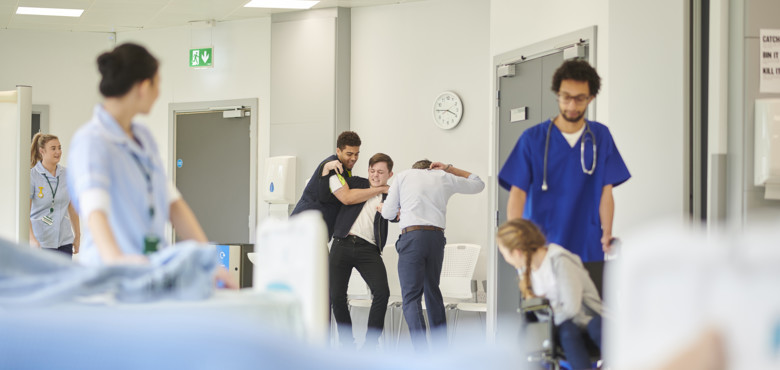Preventing workplace violence in healthcare
Workplace violence is declining, so why is it still so prevalent in healthcare facilities all over the world? A recent 2022 survey from National Nurses United (NNU) revealed significant increases in staffing issues, workplace violence, and moral distress compared to the previous year. Nearly half of hospital nurses (48 percent) reported an increase in workplace violence. This is a 119 percent increase from March 2021.
But this isn’t just a phenomenon in the US. A 2022 YouGov survey of UK NHS workers also reports ongoing experiences of violence and aggression. Three in 10 (30 percent) NHS workers who interact with patients say they experience violence from a patient at least once a year, including one in 20 (5%) who say they are subject to attacks at least once a week.
And in Chinese emergency departments, 79 percent of nurses are exposed to some form of workplace violence, with 31 percent being physical and 62 percent nonphysical.
Safety has in fact become the number one reason for nurses to leave their workplace according to research by McKinsey.
The Occupational Safety and Health Administration categorizes several risk factors for violence in healthcare facilities. Some risk factors include:
- Lack of or poor training for recognizing and managing violent and aggressive incidents from visitors, staff, patients, or clients
- Long waits for services and overcrowded waiting rooms
- Free movement of the public in healthcare settings
- Low staffing
- Notion that facilities tolerate violence and discourage or prevent victims from reporting incidents or pressing charges
- High employee turnover
- Working alone
- Poor facility design or inadequately lit rooms
- Working in neighborhoods with a high crime rate
Work aggression training on the rise
Eighty-five percent of healthcare facilities have implemented aggressive behavior training, according to a recent Hospital Security Survey conducted by Health Facilities Management and the American Society for Healthcare Engineering. And while this won’t prevent every incident from occurring, it can stop many.
Violence prevention training is an effective way to ensure hospital staff has the skills to handle aggressive behavior. For example, when staff is trained to mitigate situations, they can better recognize the warning signs of violent conduct. In turn, they have a better chance of preventing violent situations or minimizing damage before it escalates by staying calm and communicating with their colleagues.
Unfortunately, de-escalation does not work every time. The Joint Commission now requires relevant standards in reporting sentinel events and prevention of workplace violence. One solution that has been employed in hospitals, by both security and clinical staff, is the use of body worn solutions. The use of wearable solutions provides documentation of events and situations, and has shown a reduction in the overall seriousness of aggression and violence in reported incidents.
Some states have even passed laws that require healthcare facilities to develop plans to protect staff. A Delaware judge has recently fined Fuller Hospital in Attleboro for failing to provide adequate protections, particularly at times when hospital staffing was low. Similarly, Texas and Florida have both issued penalty measures to local hospitals for failing to adequately protect employees.
Various health bodies have also created free guidelines to help prevent violence and hazards in the workplace, however in-person training must also be delivered.
Low staffing in healthcare facilities
Nurses work very hard, and they’re constantly multitasking during long shifts.
When hospitals are short-staffed, they may not have time to consistently check on patients; it might only be possible for nurses to visit them to provide medication or food. Because of this, patients might feel neglected and aggressively act out for attention.
Security technology can assist hospitals with staffing shortages by helping improve how efficiently employees work. For example, surveillance systems with sound detection alert staff when it detects aggressive behavior.
Along with sound detection, employees can situate a network video intercom next to a patient’s bed so they can easily communicate with staff. To do so, patients simply press a button. This solution can improve workflow and give patients an additional sense of security in knowing that help is only a button-press away.
Although it’s impossible to anticipate and prevent all incidents of violence, being proactive can help reduce it. Total security solutions, in conjunction with aggressive behavior education and staff training, are responsible and effective ways to reduce (and at best, prevent) workplace aggression and protect the safety and security of patients and staff.
Long waits for medical services escalate aggression
Patients and their families can become frustrated and agitated when they wait for medical services or treatment. The longer the wait time, the more likely a patient will exhibit disruptive behavior. The emergency department is a prime example of this. Emergency department workers and healthcare administrators have high exposure to verbal and physical aggression. In an interview between AJMC and Leigh Vinocur MD, national spokesperson for the American College of Emergency Physicians, she describes how “you can’t go through a shift without being sworn at or spit on. If you consider verbal abuse, it’s probably daily. Eighty percent of emergency room doctors have at some point been involved in workplace violence.”
The best way to minimize this type of violence is to decrease wait times. One way to do so is by using people counting analytics, which can count the number of people in a lobby and send an alert if another staff member is needed. HIPPA compliant sound detection implemented with surveillance cameras enables staff to be proactive. The sound detection analytic can detect aggression in a person’s voice, and it’ll send an alert to staff before a situation escalates.
Free movement in healthcare settings increasing need for security protocols
Healthcare facilities are typically open and inviting environments. People, for example, can usually enter and walk through hospitals without being questioned. However, patients and visitors are frequently (and naturally so) in distress. Also, victims of violent crime or substance abuse will regularly frequent emergency departments. Given this type of public access, it’s imperative facilities maintain a high level of security to protect medicine, personnel, and patients and their medical records.
Some safety precautions healthcare facilities can take to protect from public access include:
- Stationing staff in each wing to check IDs and ask visitors why they’re visiting
- Using video and two-way audio network intercoms so personnel can communicate with people on the other side of a door and verify them before they enter a room
- Adding a visitor management and access system to control who enters or leaves restricted areas
- Installing time in area (loitering) analytics which can flag unauthorized people lingering in areas that need to be acknowledged
As you can see, there are many ways to minimize the risk of unwanted roaming.
 High pressure areas like psychiatric wards require specialized care
High pressure areas like psychiatric wards require specialized care
People with mental health issues may easily get stressed and overwhelmed in a hospital environment, especially if they’ve been there for a long period. In turn, they may lash out at staff. Statistics from the Korean Society of Nursing Science show 100 percent of nurses in psychiatric settings have been verbally abused, and 50 to 85 percent of those nurses have also experienced physical aggression.
The best way to prevent violence among patients with mental illnesses is to implement strong security measures. A few include:
- Hiring specially trained psychiatric nurses to work with these patients
- Installing access systems, which can automatically alert staff and lock doors when a patient is trying to leave his or her room
- Investing in sound detection, which can notify staff if a patient’s voice has an aggressive tone or glass breaks so they can mitigate the situation before it escalates
Facilities should take the highest measure of security possible to ensure all parties are safe.
Safety and security solutions in healthcare



